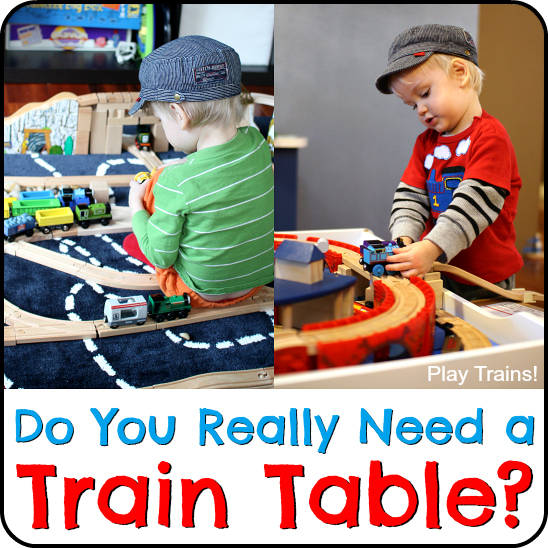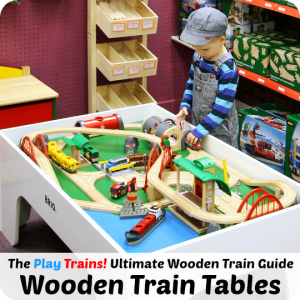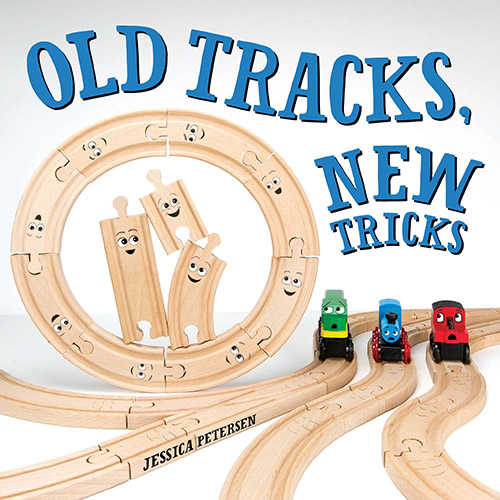Do you need a train table? The best decision regarding whether a train table is worth the cost and the space will be different for every family and school. So let’s go through the pros and cons of train tables, things I’ve learned through lots of experience and through talking with other parents and Play Trains! readers.

Posts in the Ultimate Wooden Train Guide:
The Best Wooden Train Sets
The Best Wooden Train Sets: UK Edition
The Best Wooden Train Tables for Toddlers and Preschoolers
Do You Need a Train Table?
Alternatives to Gluing Wooden Train Tracks to Train Tables
Wooden Train Tracks
Bridges and Elevated Tracks
Roundhouses and Engine Sheds
Organizing Wooden Trains and Track
Wooden Train Freight Cars
…and more to come!
Train Tables in the Home
Many children first discover wooden trains through train tables set up at bookstores and toy stores. Parents often see the magic that happens at these train tables and assume the tables have as much to do with that magic as the trains themselves. And when they buy that first wooden train set for their children, many parents pair it with a train table, wanting to reproduce that magic at home.
But here’s the thing. A train table at a bookstore is a very different thing than a train table in your own home. I’ve heard from more than one parent who was surprised and disappointed to find that their child — who was so entranced by the train tables at the store — was uninterested in a train table received as a birthday or Christmas gift. (If this happens to you, try taking the trains off the table and putting them on the floor, and see what happens.)
However, some families love their train tables, and think they’re worth every cent they paid for them — and every square inch of floor space they take up!
My own experience has been somewhere between those two extremes. In our house, the train table worked best as a novelty. Every once in a while, I would set up a train layout on the table, and it would be new and exciting…for an afternoon or two. But mostly we prefer to play trains on the floor, where we aren’t limited by space. And, being a horizontal surface, from time to time the train table would start to get buried in other stuff without me really noticing. This year, I had my husband add height to the table, and now we use it as a LEGO table — it gets much more use this way, although as I’m typing this, I know it’s currently in a buried-under-stuff phase. (We’ll have to fix that later!) So while I don’t think we needed the train table, I’m kind of glad we have it.
Ultimately, the decision to bring a train table into the home is going to depend on several factors, so let’s go through the pros and cons:
Pros
- They can look pretty cute.
- They keep the train layout contained and off the floor.
- They prevent the tracks from being knocked over as often.
- They may be safer for a very young child than walking through a train layout on the floor. I always used to worry about the Little Engineer tripping over taller sections of track when he was a toddler. (One solution to that is building the tall sections near a wall or other barrier, so children won’t be stepping over them.)
- The table may make it more comfortable for an adult to play trains with a child. Grandparents especially may appreciate being able to sit in a chair at the train table to play with their grandchildren. However, note that even if you’re sitting in a chair at the table, you’ll still be leaning over to reach the table. I actually prefer sitting on the floor next to the table. Then I don’t have to bend forward to move the trains, and I can move around the table easily.
Cons
- The standard size train table takes up a lot of floor space. Even our smaller, square table commands a big chunk of the floor. Unless you choose a long, thin DIY train table — like this Craiglist express train table from Ocean Front Shack or this rolling train table IKEA hack from TPcraft.com — you’ll also need to account for space to move around all sides of the table. When a regular-sized train table is pushed up against a wall, it can be difficult for a child to reach the blocked side of the table.
- The size and shape of the train table will severely limit the size and shape of the train track configurations you and your child can build. Even the largest train tables have this problem, and if you have a square train table like ours, it can be a real challenge to make an interesting track layout.
- There is a temptation to attach the tracks to the train table when there are young children in the house. Doing this removes a great deal of the play and learning value of the wooden trains you’re investing in, and most likely will greatly reduce the number of years your child is interested in their trains. We have a list of alternatives to permanently attaching train tracks to train tables to help you keep those tracks ready for older children to play with.
- Some children will be much less interested in the train table at home than they are in public spaces, sometimes to the point that they seem completely uninterested in a new train set. The solution to this is often to put the trains down on the floor. And then you have to figure out what to do with the train table.
Other Considerations
- Children move differently during train play around a train table than they do playing trains on the floor. The train table keeps them up on their feet — or at least their knees, as they grow. Or they can sit in a chair at the train table. Playing on the floor involves more sitting, crouching, crawling from place to place around the layout. I suspect there are pros and cons to both patterns of movement. One good thing about the table for us is it keeps my son from W-sitting, so I don’t have to remind him to “fix his feet” while we’re playing.
Train Tables in Schools
Train tables make the most sense to me in a public setting. It would be impractical to have trains strewn across the floor at a bookstore, toy store, dentist’s office, children’s museum, train show, or similar location. Most of the time, the tracks on these tables will be glued down, too, and in this case I can’t argue with that. In these public spaces, the train tables are there to entertain the children more than to provide them with a learn-through-play experience.
But at a school, I think skipping the train table — or rotating the trains away from it from time to time — is something to at least consider. Wooden trains and tracks are a wonderful addition to a block or building center. We’ve often repurposed the tracks as building materials, building tall block towers with tracks between them.
Also, when the Little Engineer was in preschool as a 2-year-old, there was a great deal of drama at the train table, and I’ve long suspected that if the tracks and train play hadn’t been confined to that table, the kids who were having trouble finding a way to play beside each other could have spread out and gotten a bit of breathing room.
However, the train table provides a nice space for kids to play with loose items off the floor. And as I mentioned above, wooden trains could be rotated from the table to the block center to mix things up. So the table is probably a good idea in a school, but if your classroom doesn’t have room for a train table, you don’t need one to have trains available to the students.
The Best Wooden Train Tables
If you’ve read this and feel that getting a train table is the best decision for you, I have a list of the best wooden train tables for toddlers and preschoolers. I’ve done my best to compare the brands and offer my thoughts on all the options I was able to find, and I hope it will be helpful in your search for the perfect train table.
This guide will be expanded with time. Have a question I didn’t answer? Ask in the comments below or by email!


Jessica
I was wondering if you had ever seen any company offering wheel sets that would attach to a block of wood that you could carve your own rail cars?
Also I didn’t notice a review of the battat line of wooden tracks/trains..
I just purchased a battat train set for my granddaughter who just loves trains!
And was wondering about compatibility..
Thank you so much for your work on all of this great information.
Hi Rick! We briefly experimented with making our own wooden trains a few years ago. The best resource we found on the topic was this Handmade Wooden Trains website. He has an article about wheels and axles that might help you find what you’re looking for.
I have a Battat set but need to play test it more to give it a full review…so far, it seems like a pretty standard set that should be compatible with most other brands, but I need to confirm that.
Just found your newsletter. I am a grandma retooling our 1980’s Brio set for my grandson who loves trains as much as his daddy did. I LOVE your article about the train table. We did buy one for our grandson, but he isn’t wild about it. And our boys (twins, now 40) always preferred the floor.. Looking forward to reading more of your posts.